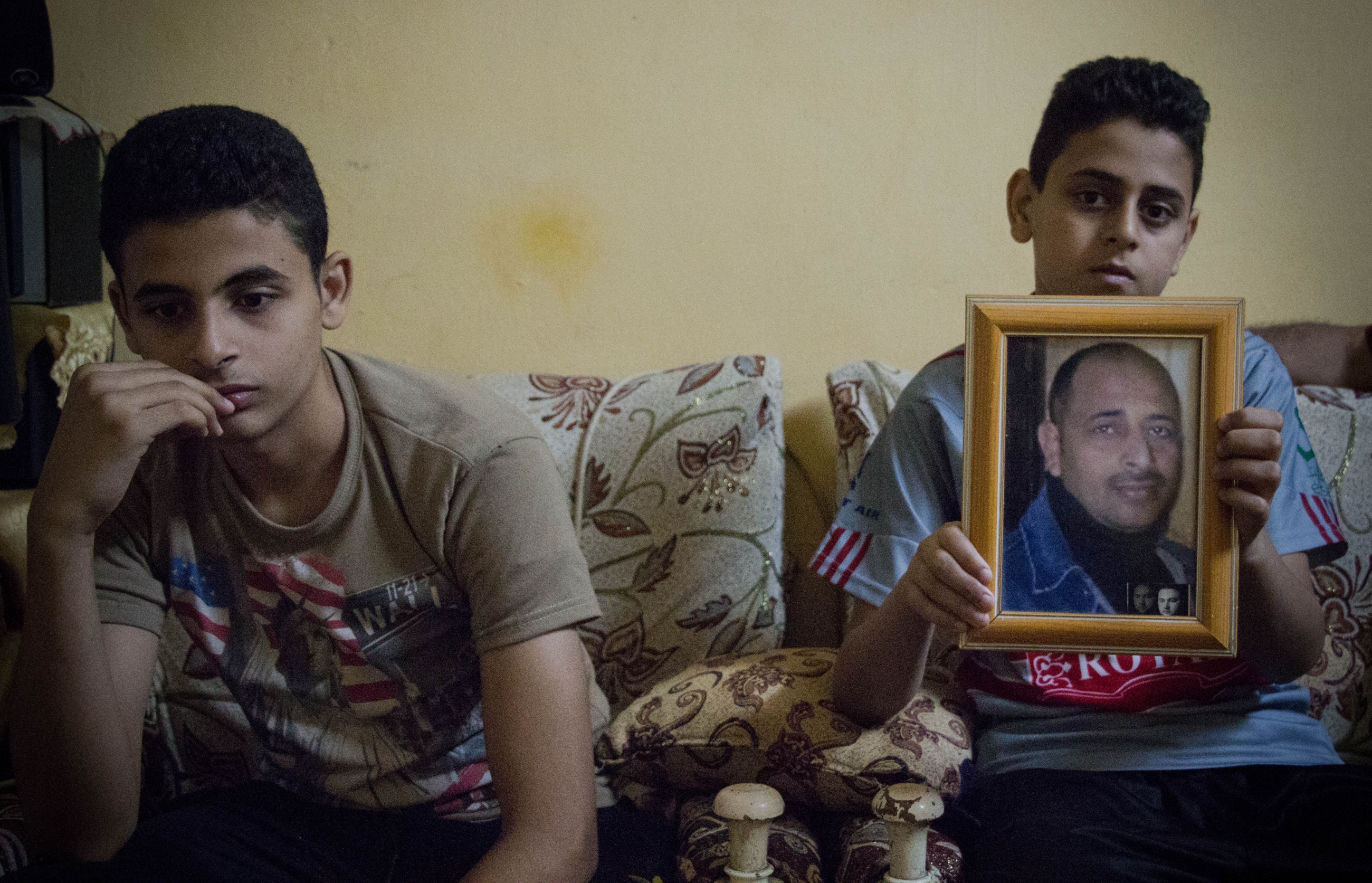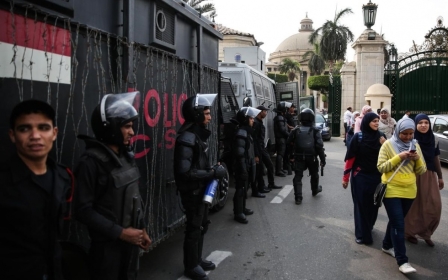Egyptian families search for the missing

Amr had just turned 18 when he went missing during the anti-Mubarak demonstrations on the Friday of Anger, on 28 January 2011. Police denied having arrested him and his corpse was nowhere to be found in the morgues.
Finally, six months later, Amr was dropped off at a small train station in the Nile Delta. He was filthy and wearing only his underwear. With him, there were four other prisoners. They had all been arrested, tortured, beaten and raped in the basement of the Wadi Natroun prison, north of the capital. None of them had been charged with a crime and there were no official records of their detention.
Amr is one of the 1,200 people who disappeared during the first month of the Egyptian revolution according to the only figure made public by the government in March 2011. Many others went missing in the following four years of turmoil and no one knows what happened to them.
As with most of those who eventually came back, Amr kept silent about his experience, out of shame and fear that police would arrest him again. Roughly a year after he had gone missing, on 2 February 2012, his sister Samah also disappeared while leaving clashes in downtown Cairo to return home.
That is when Amr finally decided to ask for help to Nermeen Yousri, co-founder of “We Will Find Them”, a grassroots campaign that investigates the thousands of people who went missing during politically related events in the past four years.
“It is impossible to have an exact figure of how many people disappeared. Mostly, they are low-class, marginalised people who do not have a voice. If they go missing, no one would care. In March 2011, the cabinet declared that there were 1200 desaparecidos, and a similar number was confirmed by the journalists’ syndicate,” she said.
However, when in February 2012 Nermeen and other activists started their campaign, they say the Egyptian government refused to collaborate, claiming they lost the documents on which that earlier report was based. “We worked on a hundred cases, but of those only 6 or 7 people actually came back,” said Nermeen. The few who return, she said, are scared to the point of denying that they had ever gone missing.
‘He probably ran away’
Mohamed Said’s brother, Ibrahim, went missing after leaving their house near the Pyramids in Giza early in the afternoon of 28 January to join demonstrations against Mubarak. He never returned. When Said went to talk to the Ministry of Interior, he said an officer told him his brother “probably ran ran away from his wife and got married to another woman.”
Mohamed and another brother, Ahmed, keep small photos of Ibrahim to show strangers who have been detained or jailed. “Look at this picture. Look carefully. Do you recognise him?” they ask. They have yet to find anyone who has met their brother.
Egypt’s various government offices and prisons were uncooperative, the brothers said, so they turned to a group of local men who had been hired to attack anti-Mubarak protestors during the revolution. “A baltagy, a thug, offered to help. He smuggled Ibrahim’s picture to some friends who were detained in two prisons, Wadi el Gedid and Wadi Natroun,” Said said. The man returned with some disheartening information. “There were at least 420 people detained with no official records in Wadi el Gedid and nearly another 150 in Wadi Natroun, but Ibrahim was not there,” Said recalled.
Sabah Sadiq only has a guess as to where her 21-year-old son, Mohamed, was when he was detained. For months, she called his phone. No answer. Until one day, a soldier answered, “I am sorry, I just found this phone in a pile of rubbish in our camp,” the soldier said. He was stationed at Gabal al Ahmar, a military base and prison in Cairo. When she visited and asked for her son, they told her that he was not there. When others from her neighbourhood eventually returned home, they just told her to stop looking for her son. “Gabal al Ahmar is where they execute prisoners sentenced to death,” someone from the neighbourhood told Middle East Eye. “When someone returns, it makes it harder for others to accept that their relative probably died,” said Nermeen.
Many, like 15 years-old Ahmed from Sharqeya, who preferred not to give his last name for fear of retaliation, were minors living outside Cairo, fascinated by the myth of a revolution they only watched on TV. Ahmed disappeared after fleeing his house to visit Tahrir Square in January 2012, only to reappear in August 2012. He was released thanks to a partial pardon granted by ex-president Mohamed Morsi in occasion of the holy month of Ramadan. He walked out of the same jail where his parents went to ask for information and were quickly dismissed.
“There is no clear pattern in all those cases, but the fact that at every significant demonstration or clashes in the past four years someone went missing,” explains Nermeen. Then, she asks, “even if people were raped, abducted or killed by criminals and not by security forces, why should thugs even bother to hide the bodies?”
Evidence of killings, torture
A fact-finding commission on alleged crimes perpetrated during the 2011 uprising has found some evidence of killings, torture and kidnapping perpetrated by security forces and the army. However, the prosecution office never opened an investigation and the final report was not published. “DNA samples of anonymous bodies, for example, could have helped found out the fate of hundreds of people missing,” said human-rights lawyer Ahmed Ragab, who was part of the commission and who laments the scarce cooperation by state authorities.
According to reports and an eye-witness who talked to the MEE on condition of anonymity, several secret military prisons exist throughout the country. One of them is a long underground series of cells dug under the desert near Suez. The army has denied its existence.
An Amnesty International investigation recently shed light on one of these secret jails, el Azouli, where several opponents of the regime are held with no formal charges or documentation that they are there. Legally, prisoners are neither free nor imprisoned, and usually they are tortured until they die, released or later re-surface in a civilian court with a forced confession.
When they do reappear in front of a judge, Hanan attends every one of those trials holding a picture of her husband Khaled, a 43-year-old manager of an electric company, hoping that some of the defendants will recognise him. Khaled was opposed to both the Muslim Brotherhood and the military. When supporters of Mohamed Morsi began the Rabaa sit-in, Khaled began visiting daily to voice opposition of the army. On 27 July, security forces, anti-coup demonstrators and residents clashed outside Rabaa Square. The last time Hanan saw him, it was on a live television broadcast of the field hospital inside Rabaa. He had been shot, and was lying on the floor of the hospital, covered in blood.
“When I saw him, I called a friend who was in Rabaa and he told me he had just been transferred to a hospital. However, the ambulance took him to a military hospital and that is when he disappeared,” she said. Hanan begged doctors to look at Khaled’s picture and to tell her what had happened to him. “Months later, a nurse confessed that he had been briefly detained in the Tora Prison hospital, despite having previously denied it,” she said.
After several months of Hanan investigating her husband’s disappearance, she found scattered information about Khaled’s movement, but no documents regarding his arrest. After the hospital, he was detained both in el Azouli and in the infamous al Aqrab block of the Tora Prison complex. Al Aqrab, which translates to “the Scorpion”, is a maximum-security facility buried in the desert two kilometres away from the main buildings of the Tora complex. It was built in 1993 to host around 100 “forgotten” inmates and it is often compared to Guantanamo Bay for the torture and abuse to which detainees are subject. Hanan knows that her husband is still probably alive and being held in one of the two prisons but, she said, for the government, he simply doesn’t exist.
Middle East Eye propose une couverture et une analyse indépendantes et incomparables du Moyen-Orient, de l’Afrique du Nord et d’autres régions du monde. Pour en savoir plus sur la reprise de ce contenu et les frais qui s’appliquent, veuillez remplir ce formulaire [en anglais]. Pour en savoir plus sur MEE, cliquez ici [en anglais].




